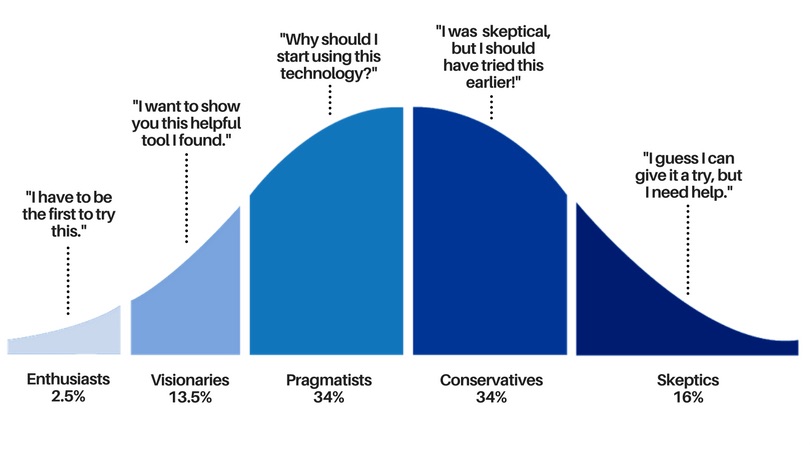

There are many factors that impact how a new product sells within a market. When marketing a new product, it’s important to understand the education industry buying cycle, and also your customer’s willingness to try something new. The Adoption Curve is a visual representation of a buying continuum based on the idea that certain individuals are more open to product innovations than others.
Nearly every product in the education market follows a similar Adoption Curve. While factors such as age, education level, income, risk-taking tendencies and social influence also delineate your audience, it’s important to pinpoint where your customers are on their adoption journey so you can precisely match your marketing communication strategies to their information needs.
Video created with the Plotagon platform.
Enthusiasts
Enthusiasts are your earliest adopters. When a new product hits the market, Enthusiasts want to be the first to try it out and discover how it will improve their workflow. They often feel duty-bound to find product downfalls and draw attention to them. When marketing to education Enthusiasts, understand they are often the most technically astute buyers. Focus on product details and highlight how your product differs from others in the market. Invite honest feedback and endeavor to head off potentially negative press before it reaches the public.
Visionaries
Visionaries are also early adopters and they pride themselves on becoming the leaders of your customer network. Visionaries are your true product evangelists. They want to be a part of the early stages of an education product, though they expect all of the bugs to be worked out. Visionaries enjoy teaching others and often purchase early in the life of a product so they can do that later. When marketing to Visionaries, spend time highlighting product features and key details that will help them promote and, in turn, sell your product.
Pragmatists
Pragmatists are a curious group of buyers. They’ve most likely been aware of your product since its inception, waiting quietly to see how the market and their friends will react. Pragmatists are more cautious with their time and money, and they need honest facts on why one product is better than another. These buyers make more emotion-driven purchases. When marketing to Pragmatists, sell product benefits over features and share stories of how others are succeeding.
Conservatives
Conservatives have additional constraints on their decision to purchase. These may include a tight budget, a tendency to be more cautious with spending, or a need for additional customer proof. By this point in the product marketing cycle, you’ll have discussed both the technical features and emotional benefits of your product. It’s beneficial to re-hit each of the product selling points with Conservatives. Often, you’ll be able to recycle a variety of existing content to give Conservatives the single convincing nudge they’re looking for to make that final purchasing decision. Show them the path others have paved and the positive experiences they’ve had.
Skeptics
Finally, there are the Skeptics. This is a group that tends to purchase new products after they are considered mainstream or traditional. When marketing to this group, it’s important to emphasize past successes through case studies, customer testimonials, product reviews and market share. Promoting your customer service or technical support team will prove to be a strong selling strategy for this group. Skeptics need to know you’ll be there when they need a patient explanation or some extra hand-holding
You can combine your knowledge of the fiscal buying schedule with the five stages of the Adoption. Together, they provide a framework to schedule customer-specific marketing within your overall education marketing strategy.
Looking to launch a new product into the education market? Let’s talk.
